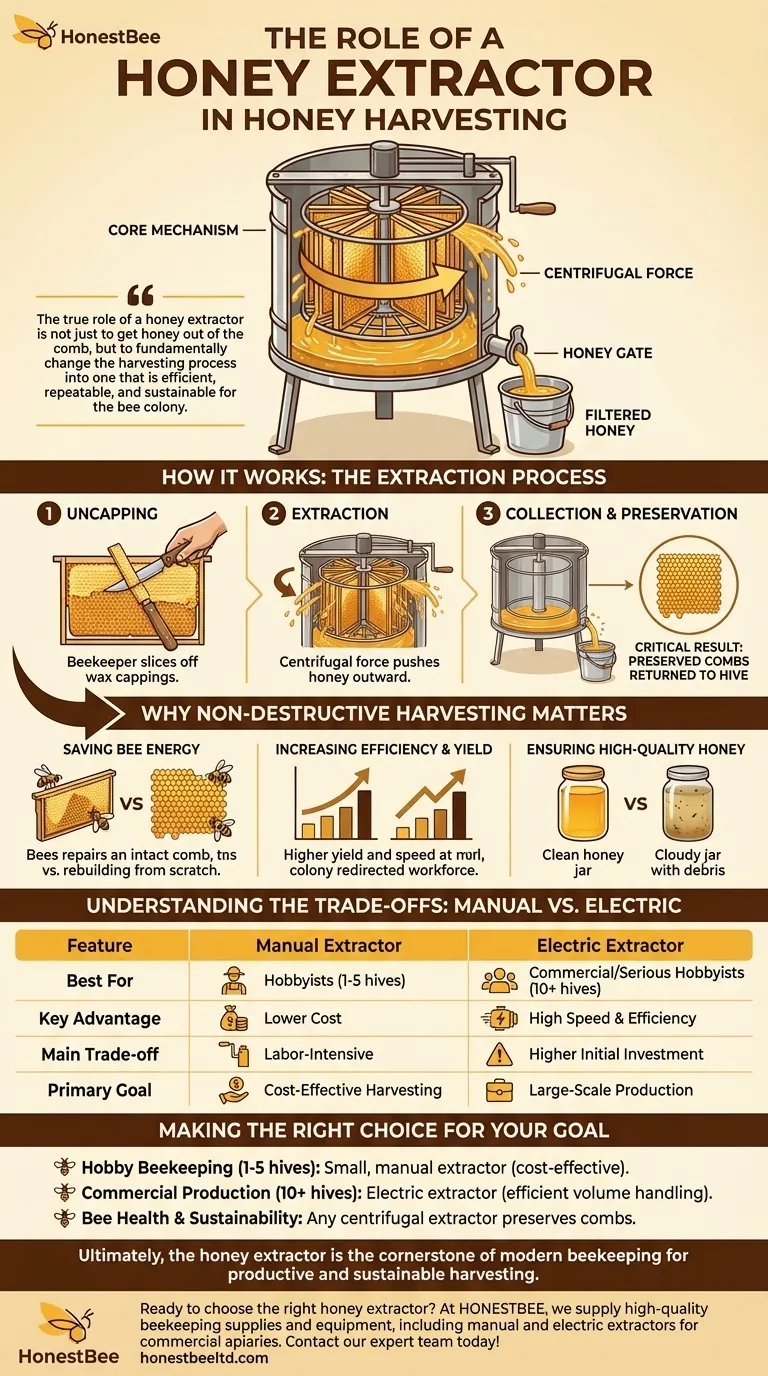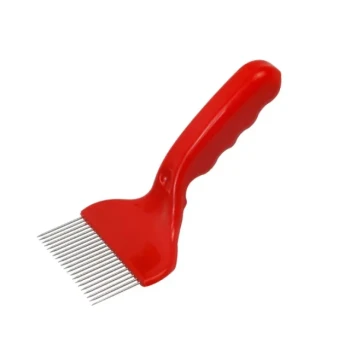At its core, a honey extractor is a machine that uses centrifugal force to spin honey out of the comb. It consists of a large drum containing a frame basket that, when rotated at high speed, flings honey from the uncapped honeycomb cells against the inner wall of the drum. This process allows beekeepers to harvest honey efficiently without destroying the delicate wax comb, which can then be returned to the hive.
The true role of a honey extractor is not just to get honey out of the comb, but to fundamentally change the harvesting process into one that is efficient, repeatable, and sustainable for the bee colony.

How a Honey Extractor Works: The Principle of Centrifugal Force
A honey extractor is a simple yet revolutionary device. Its operation is based entirely on a single principle of physics applied to the unique structure of a honeycomb.
The Core Mechanism
Every extractor has a cylindrical drum, a centrally located basket or set of reels to hold the honey frames, and a mechanism to spin that basket.
This spinning mechanism can be a manual hand crank or an electric motor. The core function remains the same regardless of the power source.
The Extraction Process
First, the beekeeper uses a special knife to slice off the thin wax cappings that bees use to seal the filled honey cells.
These uncapped frames are then placed vertically into the extractor's basket. As the basket spins, centrifugal force pushes the liquid honey outward, flinging it from the cells.
The honey strikes the inner wall of the drum, runs down to the sloped floor, and pools at the bottom. A tap, or "honey gate," at the base of the drum allows the collected honey to be drained into a bucket for filtering.
The Critical Result: Preserved Combs
After spinning out the honey from both sides of the frame, the comb structure itself remains almost entirely intact.
These "wet" frames, now empty of honey but still coated with a residue, can be returned directly to the bees. This is the single most important advantage of using an extractor.
The Advantage: Why Non-Destructive Harvesting Matters
Before the invention of the centrifugal extractor, harvesting often meant crushing the entire honeycomb to press the honey out. This was inefficient and incredibly costly for the bees.
Saving Bee Energy
Bees expend a tremendous amount of energy and resources to produce beeswax and construct the intricate hexagonal cells of a comb.
By preserving the comb, an extractor allows the beekeeper to return this valuable structure to the hive. The bees can immediately begin cleaning, repairing, and refilling it with new honey, bypassing the enormous effort of rebuilding it from scratch.
Increasing Efficiency and Yield
This conservation of bee energy directly translates to higher potential honey yields. The colony can redirect its workforce from wax production to nectar foraging.
For the beekeeper, the process is also dramatically faster. A motorized extractor can process dozens of frames in the time it would take to crush and strain just a few.
Ensuring High-Quality Honey
Extraction produces cleaner honey with far less wax debris and fewer impurities compared to the older crush-and-strain methods.
The collected honey requires minimal straining to remove any stray bits of wax before it is ready for bottling, resulting in a higher-quality final product.
Understanding the Trade-offs
While all extractors operate on the same principle, the key difference lies in how they are powered, which directly impacts their scale and cost.
Manual Extractors
These are powered by a hand crank. They are significantly less expensive and simpler, making them an excellent choice for hobbyists with only a few hives.
The trade-off is labor. Manually cranking the extractor requires physical effort and is much slower, making it impractical for large numbers of frames.
Electric Extractors
These use a motor to spin the basket, often with variable speed controls. They are the standard for commercial beekeepers or serious hobbyists.
While more expensive, an electric extractor offers unparalleled speed and efficiency, allowing a beekeeper to harvest honey from an entire apiary in a single day.
Making the Right Choice for Your Goal
Selecting the right equipment depends entirely on the scale of your beekeeping operation and your long-term goals.
- If your primary focus is hobby beekeeping (1-5 hives): A small, manual extractor is the most cost-effective and practical solution for your needs.
- If your primary focus is commercial production or a large-scale hobby (10+ hives): An electric extractor is a necessary investment to handle the volume efficiently.
- If your primary focus is bee health and sustainability: Using any type of centrifugal extractor is vastly superior to destructive methods, as it enables you to return intact combs to the hive.
Ultimately, the honey extractor is the cornerstone of modern beekeeping, empowering you to harvest honey in a way that is both productive for you and sustainable for your bees.
Summary Table:
| Feature | Manual Extractor | Electric Extractor |
|---|---|---|
| Best For | Hobbyists (1-5 hives) | Commercial/Serious Hobbyists (10+ hives) |
| Key Advantage | Lower Cost | High Speed & Efficiency |
| Main Trade-off | Labor-Intensive | Higher Initial Investment |
| Primary Goal | Cost-Effective Harvesting | Large-Scale Production |
Ready to choose the right honey extractor for your apiary?
At HONESTBEE, we supply high-quality beekeeping supplies and equipment, including a full range of manual and electric honey extractors, to commercial apiaries and beekeeping equipment distributors. Our wholesale-focused operations ensure you get durable, efficient equipment that maximizes your honey yield while protecting your bee colony's health.
Let's discuss your harvesting needs and scale. Contact our expert team today to find your perfect solution!
Visual Guide

Related Products
- HONESTBEE 72 Frame Industrial Electric Honey Extractor for Beekeeping
- 2 Frame Stainless Steel Manual Honey Spinner Extractor for Beekeeping
- electric honey extractor honey centrifuge 3 frame honey extractor stainless steel honey frame extractor
- 8-Frame Electric Self-Reversing Honey Extractor Spinner for Commercial Honey Extraction Equipment
- HONESTBEE 3-Frame Manual Acrylic Honey Extractor
People Also Ask
- How do automatic honey extractors function? Achieve High-Efficiency Honey Harvesting
- What are the advantages of automated honey extractors in terms of time efficiency? Boost Your Harvest Speed
- Why do beekeepers have to lift a lot of weight at the end of a growing season? The Reward of a Heavy Harvest
- Why is preserving honeycomb integrity important, and how do automated extractors help? Boost Hive Health & Honey Yields
- What is the energy consumption like for automatic honey extractors? Maximize Your Harvest Efficiency



















